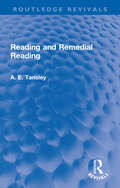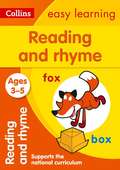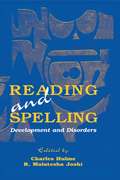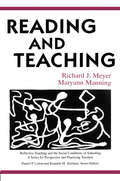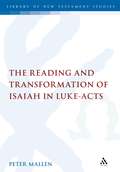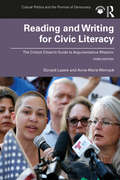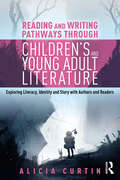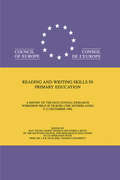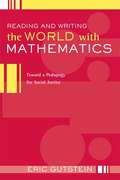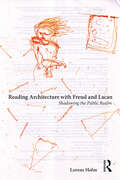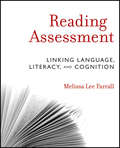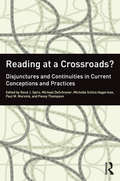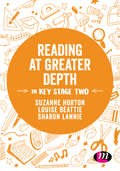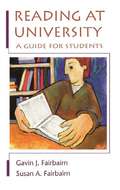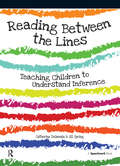- Table View
- List View
Reading and Remedial Reading (Routledge Revivals)
by A. E. TansleyFirst published in 1967, Reading and Remedial Reading describes the normal reading programme in the school where the author taught and the diagnosis and treatment of acute difficulties in learning to read. The work deals mainly with so-called educationally maladjusted children, many of whom showed signs of possible damage to the central nervous system, but Mr Tansley believes that the methods and techniques given are applicable to all children, irrespective of levels of intelligence, who are experiencing difficulties to learn. The results achieved are most encouraging and have been tested by numerous expert visitors from this country and abroad. This is a helpful guide to a large number of people- staffs and students in University Education Departments, educational psychologists, remedial teachers, special-school teachers, primary school teachers, and medical officers in the School Health Service.
Reading and Rhyme Ages 3-5 (PDF)
by Collins Easy LearningLevel: EYFS. Subject: English. Learn the easy way with this reading & rhyme activity book! Fully in line with the Early Years Foundation Stage, this English book provides reassurance whilst supporting your child’s learning at home. Combining useful English practice with engaging, colourful illustrations, this Reading and Rhyme practice book helps to boost your child’s confidence and develop good learning habits for life. Each fun activity is designed to give your child a real sense of achievement.
Reading and Spelling: Development and Disorders
by Charles Hulme R. Malatesha JoshiThis volume includes chapters by a number of leading researchers in the area of reading and spelling development. They review what is currently known about both normal and impaired development of decoding, comprehension, and spelling skills. They also consider recent work on the remediation of reading and spelling difficulties in children and discuss effective remedial strategies.
Reading and Spelling: Development and Disorders
by Charles Hulme R. Malatesha JoshiThis volume includes chapters by a number of leading researchers in the area of reading and spelling development. They review what is currently known about both normal and impaired development of decoding, comprehension, and spelling skills. They also consider recent work on the remediation of reading and spelling difficulties in children and discuss effective remedial strategies.
Reading and Teaching (Reflective Teaching and the Social Conditions of Schooling Series)
by Richard Meyer Maryann ManningReading and Teaching raises questions and provides a context for preservice and practicing teachers to understand and to reflect on the complex issues surrounding the teaching of reading in the schools. It presents real teachers in their classrooms, dialogues about that teaching, and exercises for further clarification. The purpose is to help teachers make informed choices about their teaching of reading. The text considers the different types of decisions teachers might make in the teaching of reading and the knowledge upon which they rely in making those decisions—not simply factual information about using certain materials and methods to teach reading, but also knowledge about the mind, the political climate, the broader social and cultural circumstances of their students and schools and the communities in which they teach. Reading and Teaching is designed to engage teachers in beginning to evolve their own practical theories, to help them explore and perhaps modify some basic beliefs and assumptions, and to become acquainted with other points of view. Readers are encouraged to interact with the text and to develop their own perspective on the teaching of reading. This is the fifth volume in Reflective Teaching and the Social Conditions of Schooling: A Series for Prospective and Practicing Teachers, edited by Daniel P. Liston and Kenneth M. Zeichner. It follows the same format as previous volumes in the series. *Part I includes four real-life cases of teachers’ experiences in the classroom: “Teaching Reading Via Direct Systematic Instruction”; “A New Teacher Learns About Teaching Reading and Culture”; “A Teacher-Constructed Whole Language Program”; and “Critical Literacy in an Urban Middle School.” Each case is followed by space for readers to write their own reactions and reflections, educators’ dialogue about the case, space for readers’ reactions to the educators’ dialogue, and a summary and additional questions. *Part II presents three public arguments representing different views about the teaching of reading: direct instruction, whole language, and critical literacy.*Part III offers the authors’ own interpretations of the issues raised throughout the text and some suggestions for further reflection. A list of resources is provided. This text is pertinent for all prospective and practicing teachers at any stage in their teaching careers. It can be used in any undergraduate or graduate course that addresses the teaching of reading.
Reading and Teaching (Reflective Teaching and the Social Conditions of Schooling Series)
by Richard Meyer Maryann ManningReading and Teaching raises questions and provides a context for preservice and practicing teachers to understand and to reflect on the complex issues surrounding the teaching of reading in the schools. It presents real teachers in their classrooms, dialogues about that teaching, and exercises for further clarification. The purpose is to help teachers make informed choices about their teaching of reading. The text considers the different types of decisions teachers might make in the teaching of reading and the knowledge upon which they rely in making those decisions—not simply factual information about using certain materials and methods to teach reading, but also knowledge about the mind, the political climate, the broader social and cultural circumstances of their students and schools and the communities in which they teach. Reading and Teaching is designed to engage teachers in beginning to evolve their own practical theories, to help them explore and perhaps modify some basic beliefs and assumptions, and to become acquainted with other points of view. Readers are encouraged to interact with the text and to develop their own perspective on the teaching of reading. This is the fifth volume in Reflective Teaching and the Social Conditions of Schooling: A Series for Prospective and Practicing Teachers, edited by Daniel P. Liston and Kenneth M. Zeichner. It follows the same format as previous volumes in the series. *Part I includes four real-life cases of teachers’ experiences in the classroom: “Teaching Reading Via Direct Systematic Instruction”; “A New Teacher Learns About Teaching Reading and Culture”; “A Teacher-Constructed Whole Language Program”; and “Critical Literacy in an Urban Middle School.” Each case is followed by space for readers to write their own reactions and reflections, educators’ dialogue about the case, space for readers’ reactions to the educators’ dialogue, and a summary and additional questions. *Part II presents three public arguments representing different views about the teaching of reading: direct instruction, whole language, and critical literacy.*Part III offers the authors’ own interpretations of the issues raised throughout the text and some suggestions for further reflection. A list of resources is provided. This text is pertinent for all prospective and practicing teachers at any stage in their teaching careers. It can be used in any undergraduate or graduate course that addresses the teaching of reading.
The Reading and Transformation of Isaiah in Luke-Acts (The Library of New Testament Studies #367)
by Peter MallenAn investigative study into where, how and why Luke interacts with Isaiah. References to Isaiah occur at key points in the narrative, typically introducing the mission of main characters and outlining or summarising the overall plot, suggesting that Luke utilises Isaiah as part of his interpretive framework. The overarching theme drawn from Isaiah appears to be the servant's mission to bring salvation to all people (Isa 49:6). Luke's careful selection and radical interpretation of Isaianic texts highlights surprising aspects of this theme. These include the nature and scope of salvation, the necessary suffering role of the Messiah and its connection with the proclamation of salvation, and the unexpected response to the message by Israel and the nations. Mallen's study rehabilitates the importance of the servant motif for Luke, not in terms of atonement or as a christological title but rather in supplying the job description for Jesus' messianic mission and that of his followers.
Reading and Writing for Civic Literacy: The Critical Citizen's Guide to Argumentative Rhetoric, Brief Edition (Cultural Politics and the Promise of Democracy)
by Donald Lazere Anne-Marie WomackThis rhetoric-and-reader textbook teaches college students to develop critical reading, writing, and thinking skills for self-defense in the contentious arena of American civic rhetoric. This edition is substantially updated for an era of renewed tensions over race, gender, and economic inequality—all compounded by the escalating decibel level and polarization of public rhetoric. Readings include civil rights advocate Michelle Alexander on "the new Jim Crow," recent reconsiderations of socialism versus capitalism, Naomi Wolf’s and Christine Hoff Sommers’ opposing views on "the beauty myth," a section on the rhetoric of war, and debates on identity politics, abortion, and student debt. Designed for first-year or more advanced composition and critical thinking courses, the book trains students in a wealth of techniques to locate fallacies and other weaknesses in argumentation in their prose and the writings of others. Exercises also help students understand the ideological positions and rhetorical patterns that underlie opposing views, from Ann Coulter to Bernie Sanders. Widely debated issues of whether objectivity is possible and whether there is a liberal or conservative bias in news and entertainment media, as well as in education itself, are foregrounded as topics for rhetorical analysis.
Reading and Writing for Civic Literacy: The Critical Citizen's Guide to Argumentative Rhetoric, Brief Edition (Cultural Politics and the Promise of Democracy)
by Donald Lazere Anne-Marie WomackThis rhetoric-and-reader textbook teaches college students to develop critical reading, writing, and thinking skills for self-defense in the contentious arena of American civic rhetoric. This edition is substantially updated for an era of renewed tensions over race, gender, and economic inequality—all compounded by the escalating decibel level and polarization of public rhetoric. Readings include civil rights advocate Michelle Alexander on "the new Jim Crow," recent reconsiderations of socialism versus capitalism, Naomi Wolf’s and Christine Hoff Sommers’ opposing views on "the beauty myth," a section on the rhetoric of war, and debates on identity politics, abortion, and student debt. Designed for first-year or more advanced composition and critical thinking courses, the book trains students in a wealth of techniques to locate fallacies and other weaknesses in argumentation in their prose and the writings of others. Exercises also help students understand the ideological positions and rhetorical patterns that underlie opposing views, from Ann Coulter to Bernie Sanders. Widely debated issues of whether objectivity is possible and whether there is a liberal or conservative bias in news and entertainment media, as well as in education itself, are foregrounded as topics for rhetorical analysis.
Reading and Writing Pathways through Children’s and Young Adult Literature: Exploring literacy, identity and story with authors and readers
by Alicia CurtinThis thought-provoking book will provide masters students, teachers and researchers with a toolkit and theoretical framework for teaching literacy through children's literature. It features innovative ideas for developing student and teacher experiences with literature and popular culture texts in the classroom, providing practical examples and teaching aids throughout. Taking a collaborative approach, Curtin explores how teachers and learners can engage with literature and its authors for the development of literacy in classroom practice. Connecting reader and writer identities and worlds through interviews with and suggested classroom activities from authors themselves, this text combines author, teacher and learner perspectives in the development of creative pedagogies that extend understandings of literacy beyond reading, writing and text. Exploring fairy-tales, comic books and graphic novels, children living in literature (i.e., texts which portray children, their lives and experiences), popular culture, young adult fiction, and non-fiction and digital texts such as blogs etc, this text develops a sociocultural understanding of literacy as a lived and contextually dependent practice where meaning is derived through relationships between people, settings and culture. Different contexts for literacy are explored, including reading and writing strategically (to learn about literacy and literature), widely (for personal purposes) and deeply (to transform understanding) (Short, 2011). This text will be an invaluable resource for teachers, researchers or anyone interested in reading and writing stories. The author interviews will also be of particular interest to older learners themselves as a way to develop their understanding of their own reading and writing practices. Pedagogies can be adapted to any age group, ranging from the early years to young adult.
Reading and Writing Pathways through Children’s and Young Adult Literature: Exploring literacy, identity and story with authors and readers
by Alicia CurtinThis thought-provoking book will provide masters students, teachers and researchers with a toolkit and theoretical framework for teaching literacy through children's literature. It features innovative ideas for developing student and teacher experiences with literature and popular culture texts in the classroom, providing practical examples and teaching aids throughout. Taking a collaborative approach, Curtin explores how teachers and learners can engage with literature and its authors for the development of literacy in classroom practice. Connecting reader and writer identities and worlds through interviews with and suggested classroom activities from authors themselves, this text combines author, teacher and learner perspectives in the development of creative pedagogies that extend understandings of literacy beyond reading, writing and text. Exploring fairy-tales, comic books and graphic novels, children living in literature (i.e., texts which portray children, their lives and experiences), popular culture, young adult fiction, and non-fiction and digital texts such as blogs etc, this text develops a sociocultural understanding of literacy as a lived and contextually dependent practice where meaning is derived through relationships between people, settings and culture. Different contexts for literacy are explored, including reading and writing strategically (to learn about literacy and literature), widely (for personal purposes) and deeply (to transform understanding) (Short, 2011). This text will be an invaluable resource for teachers, researchers or anyone interested in reading and writing stories. The author interviews will also be of particular interest to older learners themselves as a way to develop their understanding of their own reading and writing practices. Pedagogies can be adapted to any age group, ranging from the early years to young adult.
Reading And Writing Skills In Primary Education
by May Young Marie Thomas Pamela MunnThis book summarizes aspects of reading and writing in primary schools, interest to educationists in the UK. It outlines the general process of reading comprehension into different levels.
Reading And Writing Skills In Primary Education: A Report Of The Educational Research Workshop Held In Tilburg (the Netherlands) 9-12 December 1986
by May Young Marie Thomas Pamela MunnThis book summarizes aspects of reading and writing in primary schools, interest to educationists in the UK. It outlines the general process of reading comprehension into different levels.
Reading and Writing the World with Mathematics: Toward a Pedagogy for Social Justice (Critical Social Thought)
by Eric GutsteinMathematics education in the United States can reproduce social inequalities whether schools use either "basic-skills" curricula to prepare mainly low-income students of color for low-skilled service jobs or "standards-based" curricula to ready students for knowledge-intensive positions. And working for fundamental social change and rectifying injustice are rarely included in any mathematics curriculum. Reading and Writing the World with Mathematics argues that mathematics education should prepare students to investigate and critique injustice, and to challenge, in words and actions, oppressive structures and acts. Based on teacher-research, the book provides a theoretical framework and practical examples for how mathematics educators can connect schooling to a larger sociopolitical context and concretely teach mathematics for social justice.
Reading and Writing the World with Mathematics: Toward a Pedagogy for Social Justice (Critical Social Thought)
by Eric GutsteinMathematics education in the United States can reproduce social inequalities whether schools use either "basic-skills" curricula to prepare mainly low-income students of color for low-skilled service jobs or "standards-based" curricula to ready students for knowledge-intensive positions. And working for fundamental social change and rectifying injustice are rarely included in any mathematics curriculum. Reading and Writing the World with Mathematics argues that mathematics education should prepare students to investigate and critique injustice, and to challenge, in words and actions, oppressive structures and acts. Based on teacher-research, the book provides a theoretical framework and practical examples for how mathematics educators can connect schooling to a larger sociopolitical context and concretely teach mathematics for social justice.
Reading Architecture with Freud and Lacan: Shadowing the Public Realm
by Lorens HolmReading Architecture with Freud and Lacan: Shadowing the Public Realm methodically outlines key concepts in psychoanalytic discourse by reading them against key modern and post-modern architects. It begins with what is, arguably, the central concept for each discipline by putting the unconscious in a dialectic relation to space. Each subsequent chapter begins with a detail in architectural discourse, a kind of provocation that anchors each excursion into the thought of Freud and Lacan. The text is cyclical, episodic, and cloudlike rather than expository; the intention is not simply to explain the concept of the unconscious but, to different degrees, perform it in the text. The book offers powerful critiques of current planning practice, which has no tools to address our attachment to places. It concludes with powerful critiques of our incapacity to change the environmentally damaging ways we live our lives, which is an effect of our incapacity to recognise the presence of the death drive in our nature. The text is an extended thesis – spanning the chapters – that the field of the Other is the common grammar that organises subjects into civilisations, which has consequences for how we treat the public realm in architecture, politics, and the city. The field of the Other is a slightly different slice through the urban social world. It shadows – but does not correspond exactly to – more familiar categories like private/public, inside/outside, figure/ground, or piazza/boulevard. Reading Architecture with Freud and Lacan will be an essential resource to anyone interested in how the environment we build is a reflection of our desire. Psychoanalysis is one of the great humanist discourses of the 20th century and this book will be a valuable reference to the humanist in architects, planners, and social scientists, whether they are students, professionals, or amateurs. It will appeal to historians of the 20th century, and to psychoanalysts and architects who are interested in how their respective discourses interdigitate with each other and with other discourses.
Reading Architecture with Freud and Lacan: Shadowing the Public Realm
by Lorens HolmReading Architecture with Freud and Lacan: Shadowing the Public Realm methodically outlines key concepts in psychoanalytic discourse by reading them against key modern and post-modern architects. It begins with what is, arguably, the central concept for each discipline by putting the unconscious in a dialectic relation to space. Each subsequent chapter begins with a detail in architectural discourse, a kind of provocation that anchors each excursion into the thought of Freud and Lacan. The text is cyclical, episodic, and cloudlike rather than expository; the intention is not simply to explain the concept of the unconscious but, to different degrees, perform it in the text. The book offers powerful critiques of current planning practice, which has no tools to address our attachment to places. It concludes with powerful critiques of our incapacity to change the environmentally damaging ways we live our lives, which is an effect of our incapacity to recognise the presence of the death drive in our nature. The text is an extended thesis – spanning the chapters – that the field of the Other is the common grammar that organises subjects into civilisations, which has consequences for how we treat the public realm in architecture, politics, and the city. The field of the Other is a slightly different slice through the urban social world. It shadows – but does not correspond exactly to – more familiar categories like private/public, inside/outside, figure/ground, or piazza/boulevard. Reading Architecture with Freud and Lacan will be an essential resource to anyone interested in how the environment we build is a reflection of our desire. Psychoanalysis is one of the great humanist discourses of the 20th century and this book will be a valuable reference to the humanist in architects, planners, and social scientists, whether they are students, professionals, or amateurs. It will appeal to historians of the 20th century, and to psychoanalysts and architects who are interested in how their respective discourses interdigitate with each other and with other discourses.
Reading Assessment: Linking Language, Literacy, and Cognition
by Melissa Lee FarrallA groundbreaking integrated approach to reading assessment that addresses each child's unique Learning Profile Fifteen to twenty percent of our nation's children have reading difficulties. Educational evalua-tors must be able to use progress monitoring and diagnostic tools effectively to identify students who may be at risk, evaluate the effectiveness of school-wide reading programs, and suggest interventions that will improve reading skills. Written from a strengths-based perspective, Reading Assessment: Linking Language, Literacy, and Cognition is the first book of its kind to present a research-based, integrated review of reading, cognition, and oral language testing and assessment. Author Melissa Lee Farrall explores the theoretical underpinnings of reading, language, and literacy, explains the background of debates surrounding these topics, and provides detailed information and administration tips on the wide range of reading inventories and standardized tests that may be used in a reading psychoeducational assessment. With a focus on how to craft professional evaluation reports that illuminate a student's strengths—not just weaknesses—Reading Assessment enables school psychologists and diagnosticians, reading specialists, and special education professionals to conduct evaluations and develop effective interdisciplinary remedial recommendations and interventions. Clear, engaging, and inviting, Reading Assessment features: Case examples and practice exercises Chapter-opening reviews of each theory Strengths, weaknesses, and potential problems of tests and their interpretations Chapter-ending review questions that foster skill development and critical thinking Comprehensive information on more than 50 different assessment tests Reading Assessment is an invaluable resource that helps professionals gain the knowledge and skills to confidently interpret test results and prepare detailed and effective evaluation reports designed to meet each child's unique needs as a learner.
Reading Assessment: Linking Language, Literacy, and Cognition
by Melissa Lee FarrallA groundbreaking integrated approach to reading assessment that addresses each child's unique Learning Profile Fifteen to twenty percent of our nation's children have reading difficulties. Educational evalua-tors must be able to use progress monitoring and diagnostic tools effectively to identify students who may be at risk, evaluate the effectiveness of school-wide reading programs, and suggest interventions that will improve reading skills. Written from a strengths-based perspective, Reading Assessment: Linking Language, Literacy, and Cognition is the first book of its kind to present a research-based, integrated review of reading, cognition, and oral language testing and assessment. Author Melissa Lee Farrall explores the theoretical underpinnings of reading, language, and literacy, explains the background of debates surrounding these topics, and provides detailed information and administration tips on the wide range of reading inventories and standardized tests that may be used in a reading psychoeducational assessment. With a focus on how to craft professional evaluation reports that illuminate a student's strengths—not just weaknesses—Reading Assessment enables school psychologists and diagnosticians, reading specialists, and special education professionals to conduct evaluations and develop effective interdisciplinary remedial recommendations and interventions. Clear, engaging, and inviting, Reading Assessment features: Case examples and practice exercises Chapter-opening reviews of each theory Strengths, weaknesses, and potential problems of tests and their interpretations Chapter-ending review questions that foster skill development and critical thinking Comprehensive information on more than 50 different assessment tests Reading Assessment is an invaluable resource that helps professionals gain the knowledge and skills to confidently interpret test results and prepare detailed and effective evaluation reports designed to meet each child's unique needs as a learner.
Reading at a Crossroads?: Disjunctures and Continuities in Current Conceptions and Practices
by Penny Thompson Rand J. Spiro Michael DeSchryver Michelle Schira Hagerman Paul M. MorsinkThe Internet is transforming the experience of reading and learning-through-reading. Is this transformation effecting a radical change in reading processes as readers synthesize understandings from fragments across multiple texts? Or, conversely, is the Internet merely a new place to use the same reading skills and processes developed through experience with traditional print-based media? Are the changes in reading processes a matter of degree, or are they fundamentally new? And if so, how must reading theory, research, and instruction adjust? This volume brings together distinguished experts from the fields of reading research, teacher education, educational psychology, cognitive science, rhetoric and composition, digital humanities, and educational technology to address these questions. Every question is not answered in every chapter. How could they be? But every contributor has many thoughtful things to say about a subset of these important questions. Together, they add up to a comprehensive response to the issues the field faces as it approaches what may well be—or not —a crossroads. A website devoted to extending discussion around the book in creative (and disjunctive) ways [readingatacrossroads.net] moves it beyond the printed page.
Reading at a Crossroads?: Disjunctures and Continuities in Current Conceptions and Practices
by Penny Thompson Rand J. Spiro Michael DeSchryver Michelle Schira Hagerman Paul M. MorsinkThe Internet is transforming the experience of reading and learning-through-reading. Is this transformation effecting a radical change in reading processes as readers synthesize understandings from fragments across multiple texts? Or, conversely, is the Internet merely a new place to use the same reading skills and processes developed through experience with traditional print-based media? Are the changes in reading processes a matter of degree, or are they fundamentally new? And if so, how must reading theory, research, and instruction adjust? This volume brings together distinguished experts from the fields of reading research, teacher education, educational psychology, cognitive science, rhetoric and composition, digital humanities, and educational technology to address these questions. Every question is not answered in every chapter. How could they be? But every contributor has many thoughtful things to say about a subset of these important questions. Together, they add up to a comprehensive response to the issues the field faces as it approaches what may well be—or not —a crossroads. A website devoted to extending discussion around the book in creative (and disjunctive) ways [readingatacrossroads.net] moves it beyond the printed page.
Reading at Greater Depth in Key Stage 2 (Exploring the Primary Curriculum)
by Ms Suzanne Horton Louise Beattie Sharon LannieExpectations in primary English are high, particularly in reading. There is an emphasis on inference and deduction together with vocabulary development: two key elements for preparing pupils to access texts at a higher level. At the same time, there is also a change in the rhetoric around guided reading with teachers trying different pedagogies in order to fully prepare pupils for the demands of the reading curriculum. This book explores the various approaches to developing higher level readers.
Reading at Greater Depth in Key Stage 2 (Exploring the Primary Curriculum)
by Ms Suzanne Horton Louise Beattie Sharon LannieExpectations in primary English are high, particularly in reading. There is an emphasis on inference and deduction together with vocabulary development: two key elements for preparing pupils to access texts at a higher level. At the same time, there is also a change in the rhetoric around guided reading with teachers trying different pedagogies in order to fully prepare pupils for the demands of the reading curriculum. This book explores the various approaches to developing higher level readers.
Reading at University (UK Higher Education OUP Humanities & Social Sciences Study Skills)
by Gavin Fairbairn Susan FairbairnReading as a student demands new skills and new disciplines.Students must read. They must read to inform themselves about the subjects they are studying and to allow them to write assignments, reports and dissertations. Though most students can read fairly well, few can make as much or as efficient use as possible of the time they devote to reading for academic purposes.Many guides to study offer a pot pourri of techniques for improving reading skills. None gives as full a treatment of this essential and underpinning area of academic life as Reading at University.The authors believe that students must change both the ways in which they read and the ways in which they think about reading. This book offers effective and efficient strategies for fulfilling students' reading and study potential.
Reading Between the Lines: Understanding Inference
by Catherine Delamain Jill SpringSuitable for teachers and speech and language therapists working in the fields of language and literacy, and concerned with developing inferencing skills in their students, this book contains a collection of 300 texts which are graded, and lead the student gradually from simple tasks.
